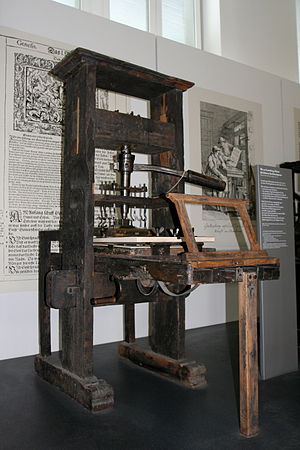
Image via Wikipedia
Technical Pipelines
Many CG artists and managers confuse the technical aspects of the CG production pipeline with the pipeline itself.
Let's look at the difference and while we're at it, look at the common attributes found in the three classes of pipelines: production, material and approval.
Let's look at the difference and while we're at it, look at the common attributes found in the three classes of pipelines: production, material and approval.
The first thing to consider is that technologies change over time. A few hundred years ago, the major technology in graphic arts was the hand printing press, similar to this German one shown here from 1811. While use of this technology required certain work flows in the production process, the technology was not the process.
If one were to decompose the CG production process into a more generalized graphic design process, one could see that a simplified production pipeline in graphic arts is comprised of:
If one were to decompose the CG production process into a more generalized graphic design process, one could see that a simplified production pipeline in graphic arts is comprised of:
- acquisition of assets
- design
- composition
- impression aka reproduction aka rendering
The Technology Pipeline
So is there such a thing as a technology pipeline? Just where does technology fit in to a production pipeline? The answer is there are technology pipelines within the realm of computer science at both the application and the hardware level, but these are not CG pipelines as such. Recall that in article #0018, Understanding Pipelines we looked at how Silicon Graphics introduced the hardware graphics engine, or graphics pipeline, in the early 1980's. The use of data piping within software and hardware is an essential part of today's CG technology. It is the most likely origin of the word "pipeline" to describe the production processes used in computer graphics today.
Fry Cooks and Bakers
Understanding the semantic link between CG pipelines and technology pipelines can, however, better help us understand what makes a pipeline a pipeline and not just a process. Let's compare frying an egg and the process of baking a cake.When frying an egg one gathers the egg, the pan and the oil in one spot, fires up the heat, oils the pan, breaks the egg in the pan and let's it warm and solidify, then flips (or not) the egg once and calls it done. This is a process, not a pipeline. The reason is there is no step by step evolution of the egg being fried.
Image by andrea dunlap via Flickr
When baking a cake, there is a recipe, on paper or in the baker's mind, and a vision of what the finished cake will look like. The baker assembles the ingredients, mixes the batter, pours the batter into a form, preheats the oven and then bakes the cake. While the cake is baking, the frosting is mixed and other decorations gathered; when the cake has baked and cooled, the baker applies the finishing decorations. This has a definite series of steps, a gradual progression of product, and can be divided into meaningful task units and these tasks may be assigned to more than one person, enabling specialization. Further, if the task is divided between specialists producing multiple cakes, these tasks can occur in parallel.
One could argue that frying an egg can be broken down into a series of tasks. The distinction is that dividing these tasks into separate processes is not meaningful when it comes to frying an egg but can be beneficial when baking a cake. So a pipeline is comprised of a sequence of processes that can flow in a linear or parallel nature relative to one another.
As this example illustrates, the processes of computer graphics together comprise a pipeline. Just as some computer software procedures can be linked together to form a pipeline for processing data, so the procedures in computer graphics are tied together to make a pipeline. However, they are not a pipeline until they are tied together.
The Three Dimensions of a Pipeline
Every pipeline, whether it is a production, material, or approval pipeline, is comprised of three dimensions that together determine its effectiveness and efficiency. In his Texas A&M University master's thesis on digital production pipelines, Dane Edward Bettis calls this the "three layer pipeline". He defines the layers as "Personnel Arrangement", "Implementation and Managing Complexity" and "Optimization of Computer Systems". To expand and simplify our thinking I see there exist three dimensions within any type of pipeline:- Personnel
- Tools
- Procedures
For example, the surface modeling process requires personnel with specific skills and abilities using tools with specific capabilities while observing specific work procedures governing not only the process but also the movement of the assets in and out of the modeling phase.
Where Technology Comes in
We can now answer our earlier question, "what is the place of technology in the production pipeline?" Unless we are replacing skilled artists with technology, which has and can happen, the technology comes in most obviously at the level of the tools employed. As Mr. Bettis makes clear in his use of the terminology "Optimization of Computer Systems", this is an area where the sharper the tool, the better. Less obvious is that the dimension of procedure lends itself to partial automation through the use of technology. A pipeline can exist with little or no automation of procedures for moving data through the system, but it will suffer from the vagaries of human error and negligence. As Mr. Bettis points out, this is an area that should be automated. He believes it so strongly that in his thesis he makes no allowance for non-automated implementation of policies and procedures related to the movement of the product through the pipeline. The degree a company can and should invest in this automation depends on factors we will discuss in a future article.
While the pipeline IS NOT the technology, as a technological art, the computer graphics pipeline depends a great deal on technology. We will explore these ideas further as we discuss in detail the three classes of pipelines: the production pipeline, the material pipeline, and the approval pipeline.
Happy Renders to you!
References:
Bettis, Dane Edward "Digital production pipelines: examining structures and methods in the computer effects industry", Texas A&M University, http://txspace.tamu.edu/handle/1969.1/2406?show=full, 2005; A useful examination of the digital pipeline with specific examples of pipeline structures.







2 comments:
sorry to be pedantic, but that image of a press you have above is not an offset press. It looks like a direct letter press.
Correction noted, appreciated and applied.
Post a Comment